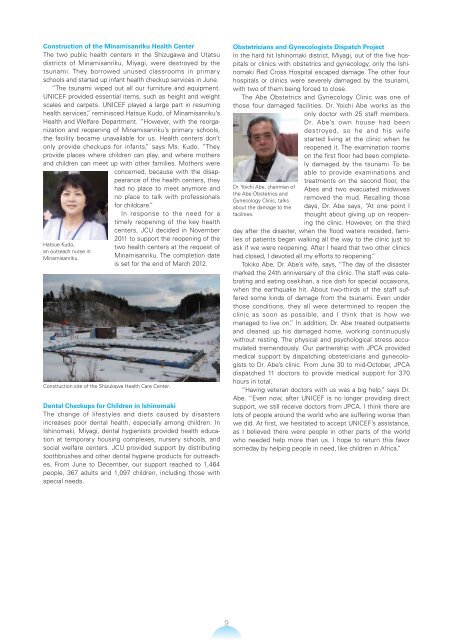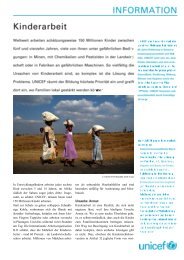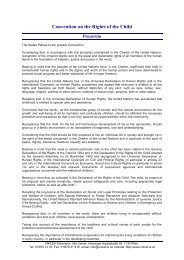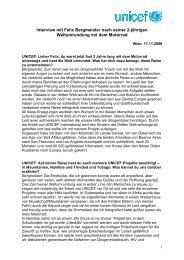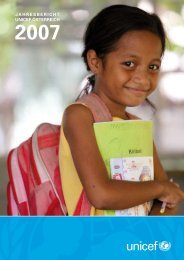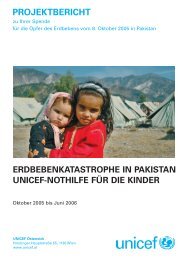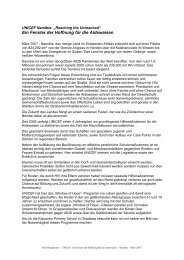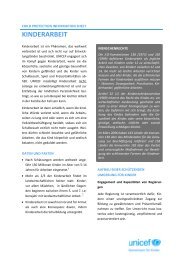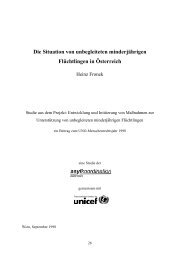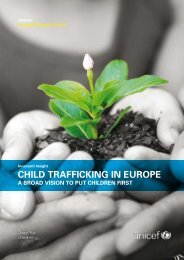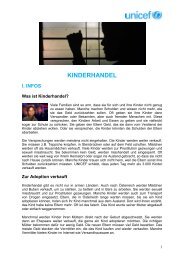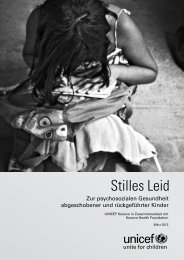You also want an ePaper? Increase the reach of your titles
YUMPU automatically turns print PDFs into web optimized ePapers that Google loves.
Construction of the Minamisanriku Health Center<br />
The two public health centers in the Shizugawa and Utatsu<br />
districts of Minamisanriku, Miyagi, were destroyed by the<br />
tsunami. They borrowed unused classrooms in primary<br />
schools and started up infant health checkup services in June.<br />
“The tsunami wiped out all our furniture and equipment.<br />
UNICEF provided essential items, such as height and weight<br />
scales and carpets. UNICEF played a large part in resuming<br />
health services,” reminisced Hatsue Kudo, of Minamisanriku’s<br />
Health and Welfare Department. “However, with the reorganization<br />
and reopening of Minamisanriku’s primary schools,<br />
the facility became unavailable for us. Health centers don’t<br />
only provide checkups for infants,” says Ms. Kudo. “They<br />
provide places where children can play, and where mothers<br />
and children can meet up with other families. Mothers were<br />
concerned, because with the disappearance<br />
of the health centers, they<br />
had no place to meet anymore and<br />
no place to talk with professionals<br />
for childcare.”<br />
In response to the need for a<br />
timely reopening of the key health<br />
centers, JCU decided in November<br />
Hatsue Kudo,<br />
an outreach nurse in<br />
Minamisanriku.<br />
2011 to support the reopening of the<br />
two health centers at the request of<br />
Minamisanriku. The completion date<br />
is set for the end of March 2012.<br />
Construction site of the Shizukawa Health Care Center.<br />
Dental Checkups for Children in Ishinomaki<br />
The change of lifestyles and diets caused by disasters<br />
increases poor dental health, especially among children. In<br />
Ishinomaki, Miyagi, dental hygienists provided health education<br />
at temporary housing complexes, nursery schools, and<br />
social welfare centers. JCU provided support by distributing<br />
toothbrushes and other dental hygiene products for outreaches.<br />
From June to December, our support reached to 1,464<br />
people, 367 adults and 1,097 children, including those with<br />
special needs.<br />
9<br />
Obstetricians and Gynecologists Dispatch Project<br />
In the hard hit Ishinomaki district, Miyagi, out of the five hospitals<br />
or clinics with obstetrics and gynecology, only the Ishinomaki<br />
Red Cross Hospital escaped damage. The other four<br />
hospitals or clinics were severely damaged by the tsunami,<br />
with two of them being forced to close.<br />
The Abe Obstetrics and Gynecology Clinic was one of<br />
those four damaged facilities. Dr. Yoichi Abe works as the<br />
only doctor with 25 staff members.<br />
Dr. Abe’s own house had been<br />
destroyed, so he and his wife<br />
started living at the clinic when he<br />
reopened it. The examination rooms<br />
on the first floor had been completely<br />
damaged by the tsunami. To be<br />
able to provide examinations and<br />
Dr. Yoichi Abe, chairman of<br />
the Abe Obstetrics and<br />
Gynecology Clinic, talks<br />
about the damage to the<br />
facilities.<br />
treatments on the second floor, the<br />
Abes and two evacuated midwives<br />
removed the mud. Recalling those<br />
days, Dr. Abe says, “At one point I<br />
thought about giving up on reopening<br />
the clinic. However, on the third<br />
day after the disaster, when the flood waters receded, families<br />
of patients began walking all the way to the clinic just to<br />
ask if we were reopening. After I heard that two other clinics<br />
had closed, I devoted all my efforts to reopening.”<br />
Tokiko Abe, Dr. Abe’s wife, says, “The day of the disaster<br />
marked the 24th anniversary of the clinic. The staff was celebrating<br />
and eating osekihan, a rice dish for special occasions,<br />
when the earthquake hit. About two-thirds of the staff suffered<br />
some kinds of damage from the tsunami. Even under<br />
those conditions, they all were determined to reopen the<br />
clinic as soon as possible, and I think that is how we<br />
managed to live on.” In addition, Dr. Abe treated outpatients<br />
and cleaned up his damaged home, working continuously<br />
without resting. The physical and psychological stress accumulated<br />
tremendously. Our partnership with JPCA provided<br />
medical support by dispatching obstetricians and gynecologists<br />
to Dr. Abe’s clinic. From June 30 to mid-October, JPCA<br />
dispatched 11 doctors to provide medical support for 370<br />
hours in total.<br />
“Having veteran doctors with us was a big help,” says Dr.<br />
Abe. “Even now, after UNICEF is no longer providing direct<br />
support, we still receive doctors from JPCA. I think there are<br />
lots of people around the world who are suffering worse than<br />
we did. At first, we hesitated to accept UNICEF’s assistance,<br />
as I believed there were people in other parts of the world<br />
who needed help more than us. I hope to return this favor<br />
someday by helping people in need, like children in Africa.”


